Chapter 6 Viewing Detailed Information About a Managed Object
The Sun Management Center Details window provides detailed information about a selected object. The following subjects are described in this chapter:
Overview of the Details Window
The details view is a subset of the Domain view. The highest hierarchical object in a details view is the host machine or module object. For more information about module objects, see To Create a Module Object. Unlike the administrative domain view, the details view enables you to see modules and the various monitored properties and statistics contained in the modules.
The Details window displays several tabs. The commonly seen tabs are shown in Table 6–1.
Click a tab to view the named information.
The tabs that appear in the Details window depend on the type of selected object. For example, the Hardware tab appears only if the Config-Reader module is supported on your system. For additional information about the tabs for your specific hardware object, see your platform supplement.
Table 6–1 Common Details Window Tabs|
Tab |
Description |
|---|---|
|
Provides general information about the managed object including name, IP address, polling type, and so on. This information is collected at the time the object is created. Info is the default view if the managed object is being monitored through SNMP or ICMP or if the object is in a non-monitored status. |
|
|
Enables you to navigate through the hierarchy and contents views of the hardware, operating system, local applications, and remote systems. Module Browser is the default view if the managed object is being monitored through a Sun Management Center agent. The Module Browser is described in Chapter 7, Browsing Information About a Managed Object. |
|
|
Displays alarm status messages and the alarm controls for the current host or node. Enables you to acknowledge or delete alarms. Alarms are described in Chapter 12, Managing Alarms. |
|
|
Module Manager |
Displays available modules and identifies which modules are loaded, scheduled, and enabled. Also indicates any modules that are multi-instance modules. Enables you to load, enable, disable, and unload modules. |
|
View Logs |
Displays information from log files, including error messages, for your host. Enables you to search, monitor, and examine system, Sun Management Center, and other log messages. |
|
Applications |
If Advanced System Monitoring add-on is installed, displays a list of applications. These applications can include the processes that are running on the host, other installed applications, and hardware information. Process information appears only if the Solaris Process Details module is loaded. Hardware information appears only if the Hardware Diagnostics Suite software is enabled. For more information about the Hardware Diagnostic Suite, view its online help. |
|
Hardware |
Displays hardware configuration information about your host for selected hardware platforms. Configuration information might include the physical and logical view of your host. This tab appears only if the hardware platform is supported by the Config-Reader module. |
Info Tab
The Info tab shows the properties table for the current managed object. The properties table is the only information that is available from the Details window for objects that are monitored through SNMP or ICMP. The general properties are listed in the following table.
Table 6–2 General Properties in the Info Tab of the Details Window|
Property |
Description |
|---|---|
|
Label you selected when you created the node. |
|
|
Optional description that you entered when you created the node. |
|
|
Machine name [The host name in this property table does not change if you change the host name on the host device. To update the information, either modify the host object, or delete the existing host object and re-create the object with the new name. See To Modify an Object.] |
|
|
IP address [When a Sun Management Center entity is added to the topology, the Topology Agent queries the entity for its configured IP address and port for the Trap Handler and Event Manager components. However, the information stored in the topology will be incorrect if the entity is ever reconfigured to correct a misconfiguration or to change the entity server-context. If the information that is shown here for the Trap Handler and Event Manager is compared with the expected configuration of the entity and does not match, remove the entity from the topology and re-enter it.] |
|
|
Netmask associated with the host |
|
|
Operating system type and version |
|
|
Hardware architecture |
|
|
Host IP address of Sun Management Center server that receives this host's trap information |
|
|
Host IP address of Sun Management Center server that receives this host's events information |
|
|
Entity Polling Type |
Agent or SNMP |
|
Host name of the target |
|
|
IP address of the target |
|
|
Agent Version |
The version number for the agent software, or 0.0 if polling type is SNMP |
|
Time zone |
The time zone in which the managed object resides |
Module Browser Tab
The Module Browser tab displays the hierarchy and contents views for managed objects that are monitored through Sun Management Center agents. These objects represent hardware, operating system, local applications, and remote systems.
See Chapter 7, Browsing Information About a Managed Object for detailed information about using the Module Browser tab.
Alarms Tab
The Alarms Details window displays the alarms for the host. For detailed information about using the Sun Management Center Alarm Manager, see Chapter 12, Managing Alarms.
Module Manager Tab
The Module Manager tab displays the loaded modules. This tab also lists those modules that are available to your system but are not currently loaded or scheduled to be loaded. You can perform the following tasks:
-
Unload a module
-
Load a module
-
Edit module parameters
-
Enable a module
-
Disable a module
-
Display module rules
-
Schedule a module for loading at a later time
For detailed information about using the Module Manager tab, see Chapter 11, Managing Modules.
View Logs Tab
The View Logs tab enables you to view several types of messages:
-
System log messages stored in the /var/adm directory
-
Sun Management Center error messages
-
Other messages
By default, only the system log messages in /var/adm are displayed. File names for these system log messages start with the word messages.
If you select the Sun Management Center Log option on the Log File menu, a list of log file choices is displayed.
The View Logs window has two scrollable panes: Messages For and Monitored Messages.
-
The Messages For area contains the filtered messages that you select using the Filter button. You can locate specific messages in this area by using the Find Message feature.
-
The Monitored Messages area contains the messages that you select using the Monitor button. New messages in this field are highlighted.
Note –
If no messages match the Filter criteria, the following message appears at the bottom of the View Logs window.
No matches found for this log file |
Applications Tab
The Applications tab enables you to view and select detailed information about processes running on the selected host or node. If you have any custom or third-party applications installed, this tab also enables you to view detailed information about processes running in the selected applications. The displays are continually updated.
View Processes
The View Processes application in Figure 6–1 enables you to view and select detailed information about processes running on the selected host or node.
The Solaris Process Details module must be loaded to use the Process Viewer. For instructions, see To Load a Module. If the Solaris Process Details module is not loaded when you click the Applications tab, you must do the following:
-
Close the Details window.
-
Load the Solaris Process Details module.
-
Reopen the Details window.
Figure 6–1 Process Viewer
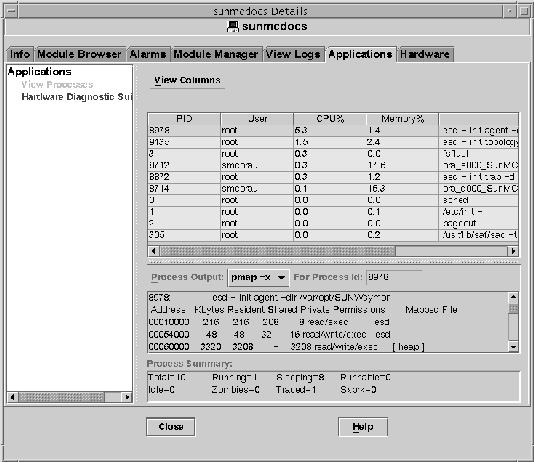
The following table lists the properties that are available in the Process Viewer.
Table 6–3 Process Viewer Properties|
Property |
Description |
|---|---|
|
Process Identifier |
|
|
Process ID of the parent process |
|
|
Effective user ID number |
|
|
Effective user login name |
|
|
Effective user ID |
|
|
Group ID of the user |
|
|
Effective group ID of the user |
|
|
Process ID of the session leader |
|
|
Process ID of the process group leader |
|
|
Tty |
Terminal that controls the process. A question mark (?) is printed when there is no controlling terminal. |
|
Time that the process started, in hours, minutes, and seconds. The start time for a process that is more than 24 hours old is given in months and days. |
|
|
Cumulative execution time for the process |
|
|
State of the process |
|
|
Address of an event for which the process is sleeping. If blank, the process is running. |
|
|
Scheduling class of the process |
|
|
Memory address of the process |
|
|
Size in pages in main memory for the image of the swappable process |
|
|
Priority of the process |
|
|
Decimal value of the system scheduling priority of the process |
|
|
Ratio of CPU time used recently to CPU time that was available in the same period, expressed as a percentage |
|
|
Ratio of the process's resident set size to the physical memory on the machine, expressed as a percentage |
|
|
Command name |
|
|
Full command name and its arguments, up to a limit of 80 characters |
Process Statistics Window
The Output For Process ID window displays the statistics for either pmap, pstack, pfiles, or pldd for any highlighted process in the Process View window.
- pmap
- pstack
-
Prints a stack trace for each lightweight process (lwp) in each process
- pfiles
-
Reports fstat and fcntl information for all open files in each process
- pldd
-
Prints dynamic libraries for the process
Process Summary Field
The Process Summary field lists statistics for all processes, active or inactive.
Custom or Third-Party Applications
Note –
To develop custom applications, you need the Sun Management Center Developer Environment and documentation. See your Sun authorized sales representative for more information.
If you have any custom or third-party applications installed on your system, they are listed below Applications - View Processes in the left side of the Applications Details window. Select the application if you do not want to view process detail information for a host or node.
After you select an application, the selected properties for the application are displayed in the right side of the Applications Details window. The properties that are shown depend on the application that is selected.
Hardware Tab
Note –
The Hardware tab does not appear if this feature is not supported on your system.
The Hardware Details window, which is shown in Figure 6–2, provides three choices for system information:
-
Hardware Summary
-
Physical View
-
Logical View
Note –
For additional information about the Hardware tab for your specific hardware object, see your platform supplement.
Figure 6–2 Hardware Details Window
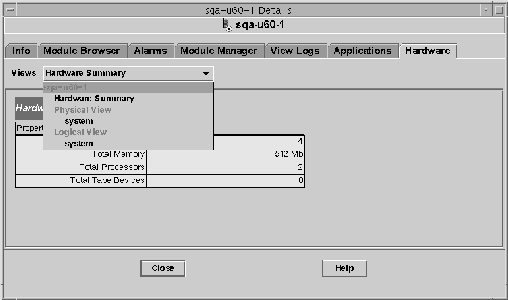
The Views menu provides access to the available hardware information.
Hardware Summary
The Sun Management Center software displays a table of hardware resources of the selected host. The following list shows some typical values displayed in the Hardware Summary.
- Total Disks
- Total Memory
- Total Processors
- Total Tape Devices
-
Total number of tape devices that are connected to the host
Your summary might appear different. The resources vary, depending on the type of object that is displayed in the detail view.
Note –
The Total Disks field displays the number of internal disks only. This number does not include the disks that are part of enclosures.
Physical View
When you select the Physical view - system option, the software displays a photo-realistic picture of the selected host, if available. Pictures are not available for some system types.
Note –
This feature is usable only if the host is monitored by a Sun Management Center agent.
As you move the mouse pointer over the picture of the system being viewed, some of the components are highlighted. The detailed component information displays in the right section of the viewing window. The path name of the component is displayed in the Component field at the bottom of the window.
If a component has an alarm, a colored line appears around the component to indicate the alarm severity. This line enables you to identify quickly the faulty component.
Figure 6–3 Hardware Configuration Physical View With Component Details (Property/Value View)
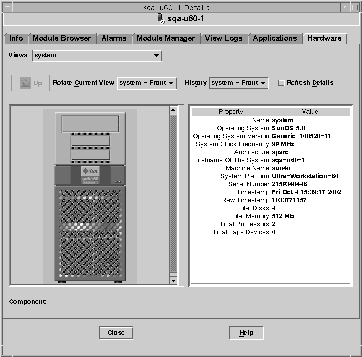
Rotate Current View Menu
For some systems, you can select alternate front, rear, and side views through the Rotate Current View pull-down menu. Pictures are not available for some system types.
For some systems, pictures of components such as CPU boards and I/O boards might also be available. As you move the mouse pointer over the system picture, the pointer changes from an arrow to a hand icon when there is an individual component picture.
Click a highlighted component to display the detailed picture of the component. When you are finished viewing component details, click Up to return to the parent system view.
Physical View When a Sun StorEdge Device is Connected
If a Sun StorEdge™ A5000, A5100, A5200, or T3 system is connected to the selected component, the Views pull-down menu lists the devices that are connected. The connected devices are listed under the system to which they are connected. The Sun StorEdge A5000-series devices are displayed on this menu as sena(0), sena(1), and so on.
You can select and view any of these storage devices from the Views menu.
History Menu
Use the History pull-down menu to revisit a view that you had selected previously.
Refresh Details Button
Click the Refresh Details button to update the Property/Value information in the right side of the Details window for the selected physical component. Otherwise, the information does not change from when you first opened the physical view.
Dynamic Reconfiguration Button
The Dynamic Reconfiguration button appears in the physical view and in the logical view only for certain platforms. Refer to your hardware supplement for more information.
Logical View
The software displays a logical view configuration of a host, if the host is monitored by a Sun Management Center agent, as illustrated in the following figure. Logical views are not available for ping hosts.
Figure 6–4 Hardware Configuration Logical View

Search Button
Click the Search button to display the Search window. Use the Search window to search for components in the Logical View topology on the left side of the viewing window. The located component is highlighted in the topology view. The name of the component displays in the Component field in the bottom right section of the screen.
The Search function is case-sensitive. If the search does not locate the component in your system, the following error message appears at the bottom of the Details window.
Node not found |
The Search function stops at the first instance found. For example, if you enter the word board, Search always stops at board(0). To find the next hit, click the Next button. To find a specific instance of a name, type a more complete name. For example, board(2).
Expand All
Click the Expand All/Recover Default button to decompress and recompress all the component icons in the topology area (left side) of the window. The compressed view is shown in the following figure.
Figure 6–5 Compressed Topology of Components in Logical View
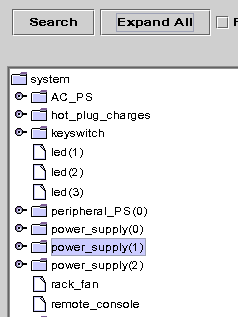
Press the Expand All button to display the expanded topology view, as shown in the following figure.
Figure 6–6 Expanded Topology of Components in Logical View
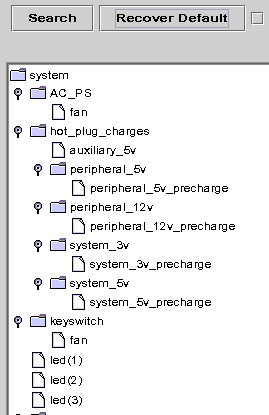
The button label toggles to Recover Default. When you press Recover Default, the topology recompresses all the component icons in the topology area of the window.
Refresh Details and Dynamic Reconfiguration
The Refresh Details and Dynamic Reconfiguration features in the Logical View are the same as the features described for the Physical View in Refresh Details Button and Dynamic Reconfiguration Button.
Navigating the Details Window
Some tabs can display many levels of detail. Double-click icons in the Details window to see additional levels of information. A category can have many subcategories.
If information in a table cell is too long to display completely, hold the mouse pointer in the cell for several seconds. The complete text that is contained in that cell appears in a pop-up window.
To expand or compress the hierarchy, use the expansion icon.The hierarchy is compressed when the icon “handle” is pointing right. The hierarchy is expanded when the icon “handle” is pointing down.
 To Start the Details Window
To Start the Details Window
-
Start the Details window in either of the following ways:
-
Double-click an object icon in either the hierarchy view or the topology view.
-
Press mouse button 3 on an object icon, and choose Details from the pop-up menu.
Tip –Be sure to select an object, not an administrative domain. The Details window is not available for administrative domains.
The Details window appears, as illustrated in the following figure.
Figure 6–7 Details Window for a Selected Object
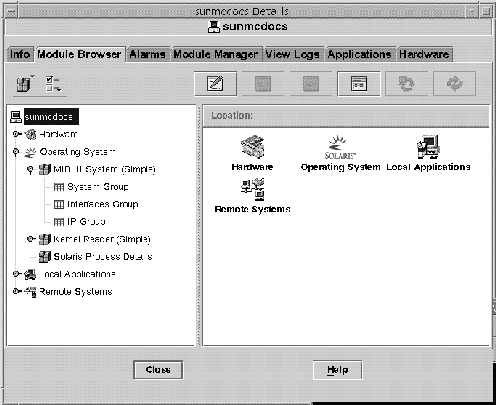
-
-
Click a tab to view detailed information for that category.
Viewing Log Files
You can view log files or portions of log files. You can also monitor log messages as the messages are added to the log files.
 To View the System Log File Messages
To View the System Log File Messages
-
In the Details window, click the View Logs tab.
-
Choose System Log from the Log File menu.
-
Click the Log File field, and select Syslog.
The System Log messages are displayed.
To refresh the display and view any new messages, click Reload.
 To Filter Your Log Request
To Filter Your Log Request
You can apply a filter to display only those messages that match the date range and text pattern that you specify. In addition, you can limit the size of the search by specifying the maximum number of matches to report.
-
With the View Logs tab selected in the Details window, click the Filter button.
The Message Filter Options dialog box is displayed, as shown in the following figure.
Figure 6–8 Message Filter Options Dialog Box
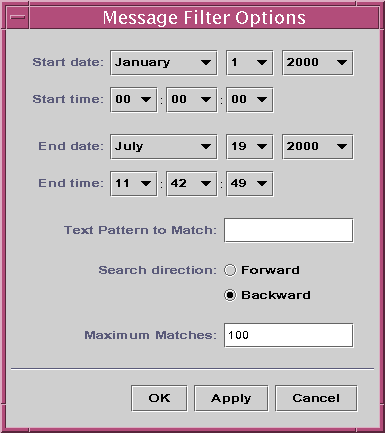
-
Select the start date for the first log message that you want to view.
-
Select the start time for the first log message that you want to view.
-
Select the end date for the last log message that you want to view.
-
Select the end time for the last log message that you want to view.
-
Type the text pattern to be matched in the Text Pattern to Match field.
Use a text pattern that is unique to the type of message in which you are interested.
-
Select Forward or Backward to specify the direction of the message search through the log file.
To begin searching from the end of the log file, select Backward. To search from the beginning, select Forward.
-
(Optional) Type the maximum number of log messages that should be matched in the Maximum matches to report field.
If you enter zero (0), all matching messages are reported, up to a maximum of 100 messages.
-
To filter and reload your log messages and close this window, click the OK button.
 To Monitor Log Messages
To Monitor Log Messages
Monitoring enables you to view new log messages as the messages occur. Each new message that arrives is highlighted.
-
Click the Monitor button on the View Logs screen.
The Monitor Filter Options dialog box is displayed, as shown in the following figure.
Figure 6–9 Monitor Filter Messages Dialog Box
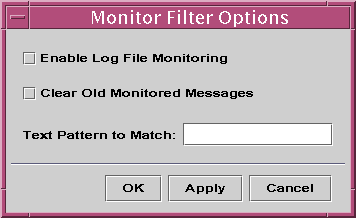
-
Select Enable Log File Monitoring to enable log file monitoring.
-
To display only currently monitored log messages, select Clear Old Monitored Messages.
-
Type the text pattern to be matched in the Text Pattern to Match field.
You can use a UNIX regular expression. For information about regular expressions, refer to the regex(1F) man page.
Use a text pattern that is unique to the type of message in which you are interested.
-
To monitor your log messages and close this window, click the OK button.
 To Find a Log Message
To Find a Log Message
You can search for a specific character sequence within a set of messages after the set has been loaded and displayed in the Messages For area.
-
Click the View Logs tab in the Details window.
-
Type the specific character sequence that you want to find in the Find field.
Note –Wildcard searches using an asterisk (*) character, are not supported in the View Logs find feature. To search for a message that contains the asterisk character, precede the character with a backslash (\), for example, \*.
-
Press Return to search the log messages for that sequence.
The first matching message is highlighted.
-
Click the down arrow or up arrow to continue your search and find additional occurrences of the matching sequence.
 To View the Sun Management Center Log File Messages
To View the Sun Management Center Log File Messages
-
With the View Logs tab selected in the Details window, choose Sun Management Center Log from the Log File menu.
A list of log files displays as a submenu.
-
Select the Sun Management Center log file that you want to view.
The messages for the selected log file are displayed.
-
To apply filters to the information, click the Filter button. Then, provide the filter parameters in the Message Filter Options dialog box.
The information is displayed using the filter that you selected.
 To Refresh Log Messages
To Refresh Log Messages
To refresh and reload the currently filtered set of log messages, click the Reload button.
 To View Other Log File Messages
To View Other Log File Messages
-
With the View Logs tab selected in the Details window, choose Other Log from the Log File menu.
Note –The Other Log option is available only if the Logview ACL module (Local Applications) is loaded.
-
To filter the log information, click the Filter button. Then, provide the filter parameters in the Message Filter Options dialog box.
The information is displayed using the filter that you selected.
Viewing Application and Process Information
You can view information about an application. You can also view information about a specific process, such as the amount of memory or CPU currently in use.
Note –
The Solaris Process Details module must be loaded to view process information. For instructions, see To Load a Module.
 To View Information About a Specific Application
To View Information About a Specific Application
-
From the Details window, click the Applications tab.
The Applications panel appears showing a list of available applications. By default, if the Solaris Process Details module is loaded:
-
The View Processes application is selected in the left side of the window.
-
Process information appears in the right side of the window.
-
-
To view information about another application, click on the application name in the list on the left side of the window.
For example, you could view information about the Hardware Diagnostic Suite. The right side of the window is updated with the selected application.
 To Display Additional Properties in the Process
Table
To Display Additional Properties in the Process
Table
By default, the View Process table displays the following information:
-
Process identifier (PID)
-
User that is running the process
-
Amount of CPU used for the process
-
Amount of memory that is used for the process
-
Command line for the process
To add additional information to the table, follow these steps:
-
In the Details window, click the Applications tab.
If the Solaris Process Details module is loaded, the View Process table appears.
-
Click the View Columns button above the Process table to see a list of available process properties.
A check mark appears next to columns that currently are in the table.
-
To add information about a property to the table, select the property that you want to add.
The selected property appears in a new column to the right of the existing columns in the table.
-
To add more properties to the table, repeat the preceding steps.
Tip –To view all process properties, select the All button at the bottom of the View Columns list.
 To Sort Columns in the Process Table
To Sort Columns in the Process Table
You can sort the processes (rows) by the properties (column headers) in ascending or descending order. For example, you can sort the CPU% column starting with either the smallest or the largest value first.
-
To sort columns in ascending order, click the property in the table column header.
The processes (rows) are updated in ascending order for that property.
-
To sort columns in descending order, click the property in the table column header while holding down the Shift key.
The processes (rows) are updated in descending order for that property.
 To Reorder Columns in the Process Table
To Reorder Columns in the Process Table
You can rearrange the order of columns.
-
To select a column, press mouse button 1 on a column header.
-
To move the column, drag the column header to the desired position and release the mouse button.
Viewing Hardware Information
Note –
If you load or unload the Config-Reader or Dynamic Reconfiguration modules while the Details window is open, you must close and reopen the Details window to see the results.
 To View a Hardware Configuration
To View a Hardware Configuration
-
In the Details window, click the Hardware tab.
The Hardware panel appears and displays a summary of hardware information.
-
Select the configuration in which you are interested.
The window is updated, and the selected feature is displayed.
 To Reconfigure the System
To Reconfigure the System
-
Open the Details window for the selected system.
-
Select the Module Manager tab in the Details window, and verify that the Dynamic Reconfiguration (dr) module is loaded.
Load the module if necessary. For information about loading modules, see To Load a Module.
-
Select the Hardware tab in the Details window.
-
From the Views Menu, choose “system” in either the Physical View or the Logical View category.
The view changes, and a Reconfiguration button appears at top of the display.
-
Click the Reconfiguration button.
-
If the Reconfiguration module is not loaded, a pop-up window displays an error message.
-
If the Reconfiguration module is loaded, the Dynamic Reconfiguration pop-up window appears.
-
-
Select a board slot or memory bank.
Dynamic Reconfiguration buttons are not available for operations that are not permitted for the selected board or memory and appear dimmed.
-
Click the desired function button for the selected memory or board.
Function
Action
Configure
Adds the selected board or memory to the system configuration. Turns on power to the board, if the board was not previously in the Connected state.
Unconfigure
Removes the selected board or memory from the system configuration. Electrical power to the board is maintained.
Connect
Turns on electrical power to the board. Basic tests of the board are run, but the board is not automatically added to the system configuration.
Note –The Configure function includes this function.
Disconnect
Turns off power to the board. The board is ready to remove when the yellow Service LED is lit, and the Power and Cycling LEDs are off.
Test Memory
Tests the selected memory.
Note –Memory tests can be time-consuming. These tests might last an hour or longer for large-capacity DIMMs.
- © 2010, Oracle Corporation and/or its affiliates
